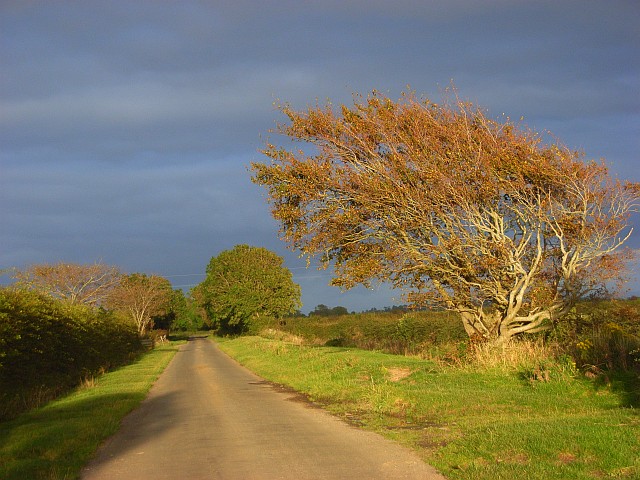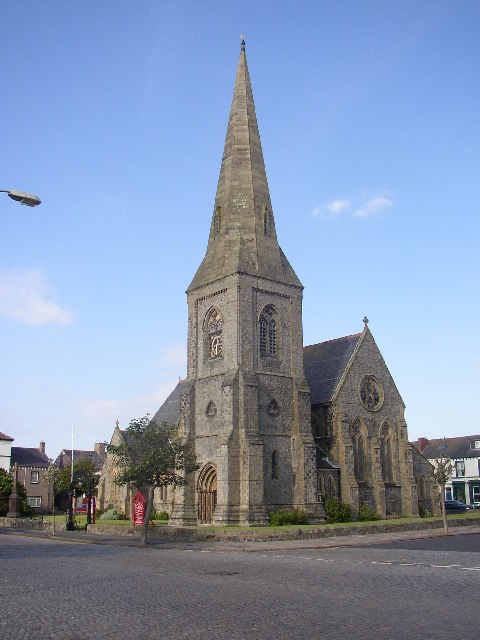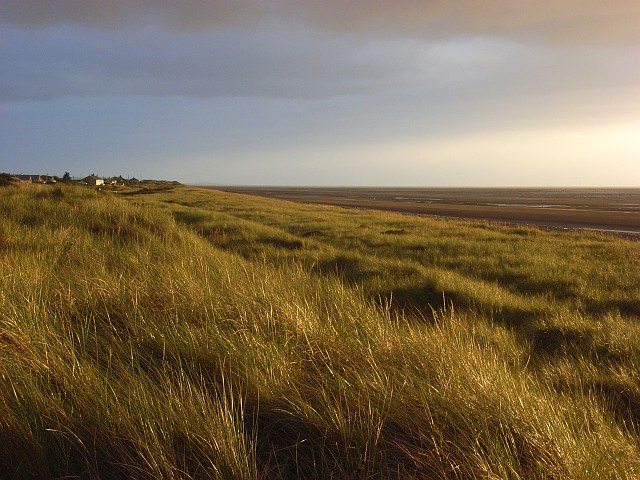|
Blitterlees
Blitterlees is a small hamlet in the parish of Holme Low, one mile south of Silloth in Cumbria, United Kingdom. The hamlet of Wolsty is located approximately to the south as the crow flies, or by road, and Cumbria's county town, Carlisle, is located to the east. The B5300, known locally as the "coast road", runs through the village on its way to Beckfoot, Mawbray, Allonby, and ultimately Maryport. History and etymology The name "Blitterlees" comes from the Old English ''blaecфorn-læs'', meaning a blackthorn pasture. Previous variant spellings include Bletterliese, Bletherleese, and Bladderlies. During the Roman period, the coast around present-day Blitterlees was fortified, as a series of milefortlets were built along the Solway plain, extending beyond the western end of Hadrian's Wall. The closest milefortlet to the settlement was milefortlet 12, which was originally constructed of earth and timber. In the 19th century, the name was spelled Blitter Lees, with a space b ... [...More Info...] [...Related Items...] OR: [Wikipedia] [Google] [Baidu] |
Carlisle And Silloth Bay Railway
There were two interlinked railways on the south shore of the Solway Firth. The Port Carlisle Dock and Railway Company was opened in 1854, following the route of a former canal, intended to connect Port Carlisle, to which sea-going ships could navigate, with the city of Carlisle. The Carlisle and Silloth Bay Railway and Dock Company was built as an extension of the Port Carlisle line, opening in 1856, because silting of the Solway was making Port Carlisle unusable. The two railways operated collaboratively, but neither was successful financially and insolvency seemed inevitable. However the North British Railway (NBR) was building the line that became the Waverley Route from Edinburgh to Carlisle. The established railways at Carlisle obstructed the NBR's intended access, so the NBR leased the Port Carlisle and the Silloth companies, and connected with them at the Port Carlisle's station in Carlisle. The NBR sent goods traffic for English destinations on to Silloth and by coasta ... [...More Info...] [...Related Items...] OR: [Wikipedia] [Google] [Baidu] |
B5300 Road
The B5300 (known locally as the Coast Road) is a B road which runs for approximately twelve miles between the towns of Silloth and Maryport in the Allerdale borough of Cumbria, United Kingdom. From north to south, it passes through the villages of Blitterlees, Beckfoot, Mawbray, Dubmill, and Allonby. It runs through the Solway Coast Area of Outstanding Natural Beauty, passes close to the Salta Moss Site of Special Scientific Interest, Milefortlet 21, a Roman archaeological site, the salt pans, a remnant of the Solway plain's medieval saltmaking industry, and the village of Crosscanonby. It is an important route for carrying goods to and from Silloth docks and Maryport harbour. It is also the major road connecting smaller coastal settlements with Maryport and Silloth, from where other roads lead to Workington, Whitehaven, Wigton, and Carlisle. A short section of the road between Dubmill and Mawbray was closed in February 2019 due to coastal erosion, and reopened in June ... [...More Info...] [...Related Items...] OR: [Wikipedia] [Google] [Baidu] |
Milefortlet 12
Milefortlet 12 (Blitterlees) was a Milefortlet of the Roman Cumbrian Coast defences. These milefortlets and intervening stone watchtowers extended from the western end of Hadrian's Wall, along the Cumbrian coast and were linked by a wooden palisade. They were contemporary with defensive structures on Hadrian's Wall. There is little to see on the ground but Milefortlet 12 has been located and excavated. The milefortlet is located close to the hamlet of Blitterlees, in the civil parish of Holme Low. Description Milefortlet 12 is situated southwest of the village of Silloth in the same parish. The site is damaged by wind erosion and quarrying, and it is covered by vegetation. Substantial earthworks were identified in 1963, and the site was excavated in 1967. The excavations showed that the fort was originally of turf and timber construction. A Roman coin hoard of 20 to 30 coins of Vespasian was found 700 metres to the east (at "Greenrow School") in 1841. Associated Towers Each m ... [...More Info...] [...Related Items...] OR: [Wikipedia] [Google] [Baidu] |
Holme Low
Holme Low is a civil parish in the Allerdale borough of Cumbria, United Kingdom. It borders the parishes of Holme St. Cuthbert and Holme Abbey to the south, the town of Silloth-on-Solway to the north-west, and has a short stretch of coastline on the Solway Firth to the west. To the north, it is bordered by lands common to Holme St. Cuthbert, Holme Low, and Holme Abbey, which is an unpopulated area. Holme Low had a population of 373 in 137 households at the 2001 census, reducing slightly in the 2011 Census to a population of 362 in 162 households. The parish is entirely rural, and the population is scattered in small hamlets. Holme Low includes the hamlets of Barracks Bridge, Blackdyke, Blitterlees, Calvo, Causewayhead, Greenrow, Seaville and Wolsty. There are bus services available in the parish, with several Silloth-bound routes passing through or close by. The number 60 from Silloth runs every two hours to Maryport along the B5300 coast road, and stops at Blitterlees, B ... [...More Info...] [...Related Items...] OR: [Wikipedia] [Google] [Baidu] |
Silloth
Silloth (sometimes known as Silloth-on-Solway) is a port town and civil parish in the Allerdale borough of Cumbria, England. Historically in the county of Cumberland, the town is an example of a Victorian seaside resort in the North of England. Silloth had a population of 2,932 at the 2001 Census, falling slightly to 2,906 at the 2011 Census. Location It sits on the shoreline of the Solway Firth, north of Workington and west of Carlisle. The town of Maryport lies south, down the B5300 coast road which also passes through the villages of Blitterlees, Beckfoot, Mawbray, and Allonby. Wigton is east, along the B5302 road, which also passes through the village of Abbeytown, southeast. History Silloth developed in the 1860s onwards around the terminus of the railway from Carlisle and associated docks which had begun construction in 1855 to replace Port Carlisle as the deep-water port for Carlisle. Workers from the factories of Carlisle were presented with access ... [...More Info...] [...Related Items...] OR: [Wikipedia] [Google] [Baidu] |
Wolsty
Wolsty is a small hamlet in the civil parish of Holme Low in Cumbria, England. It is located three-and-a-quarter miles south of Silloth-on-Solway, five miles west of Abbeytown, three-and-a-quarter miles north of the village of Mawbray, and twenty-three miles west of Cumbria's county town, Carlisle. The B5300 coast road, which heads north toward Silloth-on-Solway and south to Mawbray, Allonby, and Maryport, is three-quarters of a mile away by road, or less than a quarter of a mile by way of an unpaved farm track. History and etymology The name "Wolsty" is derived from the Old English ''wulf-stīg'', meaning a "wolf-frequented path". There have been several recorded variant spellings, including Woulstie, Worsty, Wristie, Wolmsty, and Ulsty. The area around Wolsty was fortified during the Roman period, when a series of milefortlets were constructed beyond the western end of Hadrian's Wall to guard against incursions across the Solway Firth. Milefortlets 13 and 14 are locat ... [...More Info...] [...Related Items...] OR: [Wikipedia] [Google] [Baidu] |
Maryport
Maryport is a town and civil parish in the Allerdale borough of Cumbria, England, historically in Cumberland. The town is situated just outside the Lake District National Park, at the northern end of the former Cumberland Coalfield. Location Maryport is located on the A596 road north of Workington, west of Keswick and south-west of Carlisle. The town of Silloth is to the north on the B5300 coast road, which passes through the villages of Allonby, Mawbray, Beckfoot and Blitterlees. It's the southernmost town on the Solway Firth, where the River Ellen skirts the grounds of Netherhall School before flowing through Maryport into the Solway Firth. Maryport railway station is on the Cumbrian Coast Line. History Roman and medieval times The town was established around 122 as one of several Roman localities called Alauna. It was a command and supply base for the coastal defences at the western extremity of Hadrian's Wall. The town contains substantial remains ... [...More Info...] [...Related Items...] OR: [Wikipedia] [Google] [Baidu] |
Hadrian's Wall
Hadrian's Wall ( la, Vallum Aelium), also known as the Roman Wall, Picts' Wall, or ''Vallum Hadriani'' in Latin, is a former defensive fortification of the Roman province of Britannia, begun in AD 122 in the reign of the Emperor Hadrian. Running from Wallsend on the River Tyne in the east to Bowness-on-Solway in the west of what is now northern England, it was a stone wall with large ditches in front of it and behind it that crossed the whole width of the island. Soldiers were garrisoned along the line of the wall in large forts, smaller milecastles and intervening turrets. In addition to the wall's defensive military role, its gates may have been customs posts. A significant portion of the wall still stands and can be followed on foot along the adjoining Hadrian's Wall Path. The largest Roman archaeological feature in Britain, it runs a total of in northern England. Regarded as a British cultural icon, Hadrian's Wall is one of Britain's major ancient tourist attra ... [...More Info...] [...Related Items...] OR: [Wikipedia] [Google] [Baidu] |
Aspatria
Aspatria is a town and civil parish in the non-metropolitan district of Allerdale, and is currently embraced in the Parliamentary constituency of Workington, Cumbria, England. Historically within Cumberland the town rests on the north side of the Ellen Valley, overlooking a panoramic view of the countryside, with Skiddaw to the South and the Solway Firth to the North. Its developments are aligned approximately east-west along the A596 Carlisle to Workington road and these extend to approximately 2 miles (3 km) in length. It lies about 8 miles (12 km) northeast of Maryport, a similar distance to the Southwest of Wigton, about 9 miles (14 km) north of Cockermouth and 5 miles (8 km) from the coast and Allonby. It comprises the townships of Aspatria and Brayton, Hayton and Mealo, and Oughterside and Allerby, the united area being ; while the township takes up an area of . In earlier days a Roman road leading from " Old Carlisle" to Ellenborough passed through ... [...More Info...] [...Related Items...] OR: [Wikipedia] [Google] [Baidu] |
Aspatria Railway Station
Aspatria railway station is a railway station serving the town of Aspatria in Cumbria, England. It is on the Cumbrian Coast Line, which runs between and . It is owned by Network Rail and managed by Northern Trains. History The station was opened by the Maryport and Carlisle Railway on 12 April 1841, although the line heading north-east to Wigton was not completed until 1845. The station was once the junction for the branch line to Mealsgate. Passenger trains on this line began on 2 April 1866, but ceased on 22 September 1930. Complete closure of the line followed on 1 December 1952. The station became part of the London, Midland and Scottish Railway during the Grouping of 1923, and then passed on to the London Midland Region of British Railways on nationalisation in 1948. When sectorisation was introduced in the 1980s, the station was served by Regional Railways until the privatisation of British Railways. The station signal box was the last surviving example built by t ... [...More Info...] [...Related Items...] OR: [Wikipedia] [Google] [Baidu] |
Area Of Outstanding Natural Beauty
An Area of Outstanding Natural Beauty (AONB; , AHNE) is an area of countryside in England, Wales, and Northern Ireland, that has been designated for conservation due to its significant landscape value. Areas are designated in recognition of their national importance by the relevant public body: Natural England, Natural Resources Wales, and the Northern Ireland Environment Agency respectively. In place of AONB, Scotland uses the similar national scenic area (NSA) designation. Areas of Outstanding Natural Beauty enjoy levels of protection from development similar to those of UK national parks, but unlike national parks the responsible bodies do not have their own planning powers. They also differ from national parks in their more limited opportunities for extensive outdoor recreation. History The idea for what would eventually become the AONB designation was first put forward by John Dower in his 1945 ''Report to the Government on National Parks in England and Wales''. D ... [...More Info...] [...Related Items...] OR: [Wikipedia] [Google] [Baidu] |
Solway Coast
The Solway Coast is a designated Area of Outstanding Natural Beauty in northern Cumbria, United Kingdom. It incorporates two areas of coastline along the Solway Firth, the first running from just north of the city of Carlisle, at the estuary of the rivers Esk and Eden, in a westerly direction as far as Silloth-on-Solway, including the villages of Bowness-on-Solway, Burgh-by-Sands, Port Carlisle, and Skinburness. The second area begins just north of the hamlet of Beckfoot, and runs south down the coast to the southern end of Allonby Bay near the village of Crosscanonby. Included in this area are the villages of Mawbray and Allonby, and the hamlets of Dubmill, Hailforth and Salta. The hamlet of Wolsty lies just outside the AONB. Beginning at Silloth, the B5300 coast road runs in a south-westerly direction, entering the AONB just north of Beckfoot, and exiting near Crosscanonby. Status Areas of Outstanding Natural Beauty in England and Wales are designated as such ... [...More Info...] [...Related Items...] OR: [Wikipedia] [Google] [Baidu] |








